
Endless Forms Most Beautiful: The New Science of Evo Devo
Book Description
What if the blueprint of life isn't merely survival of the fittest, but a symphony of genes orchestrating wonders? In "Endless Forms Most Beautiful," Sean B. Carroll takes you on a breathtaking journey through the revolutionary world of evolutionary developmental biology. Unravel the mysteries of how small genetic shifts can give rise to the vast diversity of life we see today. From the intricate designs of butterfly wings to the enigmatic structures of vertebrates, the elegance of evolution unveils profound truths about our own existence. Are we ready to embrace the astonishing potential hidden within our DNA?
Quick Book Summary
"Endless Forms Most Beautiful" by Sean B. Carroll explores the emerging field of evolutionary developmental biology, or "evo devo," which bridges genetics, evolution, and embryology to explain the diversity of life. Carroll describes how all animals share a common genetic toolkit – a set of master regulatory genes – and shows how minute changes in these genes’ deployment can create the incredible variety of forms seen in nature. Through vivid examples, such as the patterns on butterfly wings and limb development in vertebrates, the book illustrates how evolution acts not just through survival, but through rewiring the development of organisms. Carroll makes the complex science engaging and accessible, inviting readers to reconsider the origin of biological diversity and our own evolutionary story.
Summary of Key Ideas
Table of Contents
The Genetic Toolkit Shared Across Life
Carroll begins by introducing the concept of the genetic "toolkit"—a suite of master genes, such as Hox genes, responsible for managing the development of animal bodies. Despite the vast diversity among animals, these genes are surprisingly conserved, passed down from ancient ancestors. The discovery of these toolkit genes revealed that nature doesn’t reinvent the wheel for each new organism. Instead, it modifies existing genetic programs, which Carroll likens to using the same set of LEGO pieces to build dramatically different designs.
How Small Genetic Changes Lead to Big Evolutions
A central theme of the book is how small changes in gene regulation, rather than the genes themselves, drive evolution. Carroll explains that the timing and location of gene expression during embryonic development can lead to significant changes in an organism’s form. Using specific examples, such as the evolution of butterfly wing patterns and the differences in vertebrate limbs, he demonstrates how tweaks in genetic switches shape morphology. These genetic modifications accumulate over generations, fueling the endless variety noted by Darwin.
Pattern Formation and Body Plans
Carroll connects historical discoveries in embryology with cutting-edge genetic research, showcasing the interdisciplinary nature of evo devo. He revisits classic experiments—like manipulating fly embryos—and shows how new molecular techniques have clarified the mechanisms underlying pattern formation and body plans. By linking observations from 19th-century naturalists with modern genetics, Carroll illustrates the continuity and progress of biological science, explaining how developmental processes drive macroevolutionary change.
Discoveries from Embryology to Genetics
Through accessible language and engaging storytelling, Carroll brings readers into the laboratory, sharing both the excitement of discovery and the challenges faced by researchers. His use of analogies, such as genetic toolkits and switches, demystifies complex ideas, making them relatable. The book not only explains scientific concepts but also celebrates the creativity and wonder of nature, emphasizing that life’s diversity arises from the interplay of rules and chance within the genetic code.
Implications for Understanding Human Origins
In his conclusion, Carroll discusses the implications of evo devo for understanding human evolution and our place in the natural world. By tracing our own development back through the genetic toolkit, he reveals deep connections with other organisms and highlights the shared ancestry of all animals. The book encourages readers to see evolution as both a scientific explanation and a source of awe, revealing the hidden logic and beauty woven into the tapestry of life.
Download This Summary
Get a free PDF of this summary instantly — no email required.





